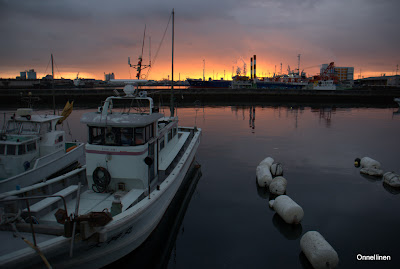Ok, the cooler-box was almost empty of fish. The catch was much smaller than expected (like every time). Here's a brief recap of what happened.
The morning started with 4:15 wakeup after which I was to meet the boat owner at 5:00 in front of he's store. Still door shut at the above photo, the store is the oldest fishing supply shop in Oita.
The shop has been passed on along three generations. The present owner Mr. Kouriki (the rare name means God's power), had taken over the business from his father who had suddenly died.
His grandfather had established the store in Miyakomachi, currently a well-known for its bars, restaurants and active nightlife. But at the time when they opened doors in early Showa period, the area was totally different: there was no sign of the red light district atmosphere neither were there salary men wandering wasted in the early morning hours.
Kouriki has run the store for 17 years but on the side he does fishing trips with his boat. His parents had bought the boat in the turn in mid-80s when massive fishing boom had hit Oita.
The boom was created when two local fishes: Aji (horse mackerel; piikkimakrilli) and saba (mackerel; makrilli) were specially branded and sold with a price of about 10,000 yen (88 eur) a piece, which is 6-10 times higher than same fish caught elsewhere.
Anyways, before the nineties the fish were abundant, and though the boat had cost a sum equal to two detached houses the fishing business was so good that the investment had soon paid itself off.
Where 648 tons of saba only was caught in 1984 from the area that surrounds Saganoseki peninsula, in 2006 the figure was 99 tons. Today are now times when no fish is caught in single day. Two major reasons have accounted to the drop: intense fishing and overall higher water temperature. I would bet on the first one and add up the industrial zone that processes iron and steel, oil, and chemicals.
So the above was an attempt to explain our modest catch, because at least the equipment was top-class. Actually the technology was too good. Sonar scanner probing for fishes 40 meters below the surface. Then the electronic reels, that indicate how deep is the bait at any given time. On the photo the lure is diving at 27.2 meters, where we had earlier seen some movement from the fishfinder.
But even with the help of modern technology plenty of luck is needed. Three hours of without a catch except, except hundreds of these kind of jellyfishes. No wonder people call it jellyfish because as soon as you lift one up to the air its starts to melt down like jelly (see the slime dripping down the jellyfish).
Quite different from what I've used in Finland: the bait; several frozen blocks of tiny shrimp that during the course of our trip first melt and then started to brew nicely under the burning sun. Natto, the fermented beans are nothing in comparison to the infernal stink of warm fish bait.
After spending a day at the sea it was time to return. Fortunately we didn't have to return completely empty-handed. Personal catch of the day: 1 saba, 4 tais (red seabream; pilkkupagelli).
All that was left after being exhausted, covered in the stink of fish, and badly burnt by sun was cutting and cooking.
Saba, ready to be diced in to pieces of sashimi. Result below.
And the salted tais before grilling. OK. That's about it of the day. Except for one more photo.
That's only a part of the burnt skin... I tell you, it hurts a bit.
Subscribe to:
Post Comments (Atom)













0 comments (click to write a comment):
Post a Comment